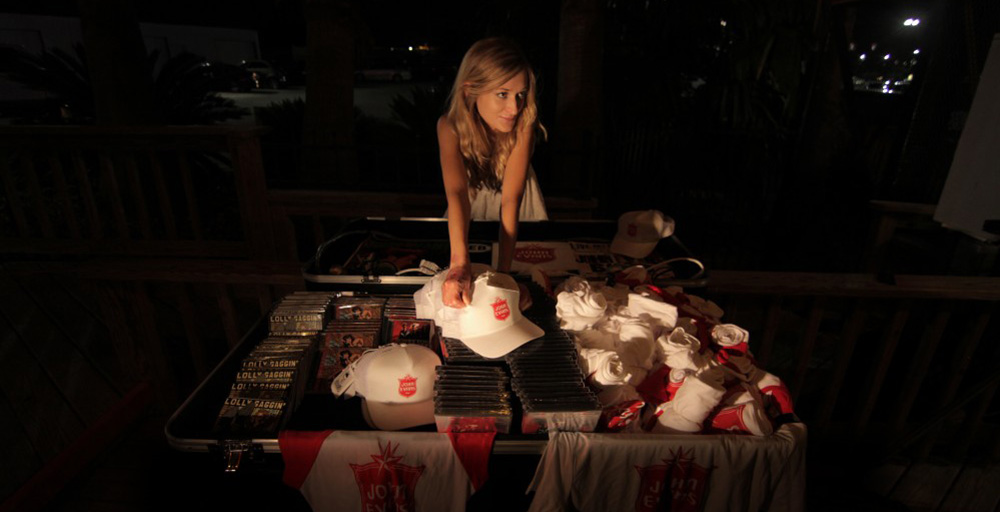When Cary Bell and Jessica Miller embarked on their first feature “Butterfly Girl,” they worried how no matter how much time they had with their teenage subject Abigail Evans, it might not ever be enough to tell a fully-realized story. Then Bell reflected on her own coming of age.
“I remembered being a teenager, but I didn’t quite remember when you’re 18 years old, four months is like four years in adult time,” says Bell. “In the four months we were with [Abigail], that girl went through everything you could think of.”
More than most, Abigail Evans had reason to grow up fast. Born with epidermolysis bullosa, a rare disorder which stems from a missing gene that bonds skin to the rest of the body, Evans is required to visit the doctor’s office in between tennis and violin lessons to tend to the blisters and scabs that easily form on her hands and feet. Otherwise, she is no different than other teens in terms of craving independence, though with a life expectancy of just 30, her desire to become her own person, outside of both her affliction and her parents, who have tried to provide her with as ordinary a life as possible, is particularly intense.
That drive fuels “Butterfly Girl,” which roars out the gates to the rock ‘n’ roll stylings of Abbie’s father, well-known Texas rockabilly singer/songwriter John Evans, as the two hit the road on tour and never looks back. The film follows the flaxen blonde as she accompanies John on tour as a merch girl, a way for him to keep an eye on her while allowing her out into the world, and develops her own plans to leave Austin for California, a journey that director Bell and editor and producer Miller capture with all the effervescence of its main character. Shortly after the film’s debut at SXSW, the two talked about how they first met Evans, how being not too far removed from Evans in terms of age and gender may have helped and their film’s emotional premiere. Warning, there are major spoilers at the end of this article.

Cary Bell: Yes, and a lot of thought went into it, now that you mention that. We tried a lot of things, figuring out how to depict the Austin that you know and I and everybody that lives here knows. We wanted to do it in not in a heavy-handed way, but in a way that just felt natural. It took a lot of work, actually.
The same could be said for the overall look of the film, I imagine, because from the start with the way you film, it doesn’t feel like a documentary.
CB: We knew we wanted to make a film that felt like a narrative from the beginning. It was a choice that Jess [Miller] and I made from the beginning and just [required] long production hours, long set-up hours, and making sure that our cameras were mounted right. I don’t like using a lot of gear as a director for a documentary, which you would think would make it look worse, but we just picked the right cameras and our cinematographer’s very talented.
Jessica Miller: From day one, Cary was like, “Okay, there’s a van down the highway and ‘Dust Bowl’ is playing.” That was always the plan.
CB: It set the tone for the film.
How did you first learn of Abbie’s story?
CB: Abbie’s father John Evans is a pretty big musician here in Austin and Jess and I were at one of his shows about three years ago, we met Abbie for the first time. John’s partner is actually my sister, who’s also a musician and the music in the film that’s [sung by a] female is hers. It’s produced by John as well, so every note of music in the project, he has his hands on it somehow. That’s how we all got to know each other.
How did the music guide the film?
JM: When we decided we wanted to make a documentary about Abbie, we were like, “Well, John’s music has to be in it.” That’s like the score of her life. She’s his biggest fan. She goes to his shows all the time, selling his merch. So it was a no-brainer that that’s what we were going to do, then we started looking at his music, and he’s got a huge, very beautiful back catalog. As an editor, it was a dream to work with. We used it as narration throughout the film in certain scenes.
Because of her condition, Abbie has to live a bit of a sheltered life. Did the fact that you were young women, but slightly older than Abbie allow you access from both her parents and from her that you think you might not otherwise have gotten?
CB: Being women, I don’t think that Abbie would’ve opened up to a man the way that she did. Not just a woman being close to her age, but in general. I obviously spent a lot of time with Abigail, and it was always important for me to not be her friend. I’m friendly with her, but I wanted to be more than a friend, almost like a role model and a guide for her in a way. Those lines can so easily get blurred. I remember one time we were filming an interview, and I think my sister, John’s girlfriend, came into the room. Abbie was drinking a beer. She started to yell at me, “Why are you letting her drink a beer?” I’m like, “Not my job!” I didn’t give her the beer, but I also am not going to tell her not to drink it.
But as a director, I have a big problem filming people that are drunk. We filmed in bars a lot and there were obviously a lot of drunk people around, so I tried to be an example in that respect and we were older enough that we could say to her, “Maybe you shouldn’t run off far away and drink all of that alcohol behind closed doors.”
Did Abbie’s story naturally lend itself to a film or was it tricky to find the shape?
JM: There’s lots of things that were going on that that first we weren’t sure the right way to do. For one thing, we’re educating people about this disease and we also learned about her. We did posts for on and off for two years, and we did test screenings. We ended up taking that into consideration and forming the narrative that we have now. When we really got this kind of story arc was about four or five months ago.
CB: Yeah, but the story was always there. From two weeks into filming on, we knew what the story was going to be. It’s about Abbie coming of age and trying to figure out how to find independence when you have a life-threatening disease. It’s hard enough as it is to be 18 and try and get out of the house., Another filmmaker might have come in here and interviewed the doctors and done a whole expedition on the disease, which we didn’t want to do.
JM: At first, you know, [Cary’s] filming with Abbie and it’s like, “What does she want?” The fact that she wanted to go to Stanford, we’re very lucky that we had that at the beginning of the film. She said, “It’s my dream.” We didn’t know if that was going to happen and throughout the way, we were very aware of how the narrative would have to form because of that.

CB: There’s still things I wonder. Someone at the Q&A today asked about her [test] results. We have tried so hard to make it clear that there are no results. It’s still so complicated that I’ve spent two years living with the information about this disease, I still don’t understand it. Abbie had it. She doesn’t understand it. That’s what’s so fascinating about it, is that it’s so complicated. Gene therapy and stem cell research is the only future for a disease like this, so it took a while to [figure out to explain it].
I have to admit, I was gravely concerned when she ordered crawfish, knowing she’d have to pluck out the meat.
JM: Yeah. People often say that too, when she’s out in the rain they’re like, “Oh, she’s going to fall! Will she be okay?”
CB: Or when the pitbull is on her lap.
JM: But we wanted to be informative [about epidermolysis bullosa] in a minimal way, because it’s not a disease film. She’s Abbie, not this girl with this disease.
How did you get interested in filmmaking?
CB: I started in theater when I was really young. I’ve always been behind the scenes, not in front. Then at some point, I just realized that nonfiction’s my thing. I’ve worked at CNN and in journalism and I currently do work in nonfiction television development, but the dream, of course, is to make feature-length documentaries. Which is such a hard thing to do and such a curse to want it, but it’s just what I’ve always done.
JM: I love watching movies, so I tried acting and was awful at it, I hated it. So I was like, “Oh, maybe directing?” I hated it. I would take a camera and be like, “I’ll fix it in post.” I learned to edit when I was 12 and I realized that most people hate editing, so I’m like, “Oh, lucky me, I love it!”
CB: She’s a freak. She sits in the room for 12 hours and stares at a computer, watching the same thing over and over again.
JM: Once I met Cary, and saw her produce, I was like, “I want to produce with you!” That’s been our relationship since college and our creative process has been evolving.
CB: Yeah, it’s such a cool job to do what we do, specifically with real life. I personally get to go all over the place and meet tons of new people all the time and making a film like this, you get to comment on life. It’s such an honor.
[Spoilers ahead] The end title card comes as a shock. Did it affect what you wanted to do with the film while in editing?
jm: As you know, in December, Abbie passed away. We pretty much had locked our picture in November, right before we submitted to SXSW. The epilogue that you see now used to be something different, but it was really important to us that the film didn’t change. We were accepted in the festival based on the cut that they saw before she passed away and it’s about her life, so we didn’t change it. But it was necessary for us to tell an audience that she’s no longer here. We talked a lot about that.
CB: We decided that the best way would be to almost be reassured by Abbie herself that it’s okay.
Was the premiere bittersweet? It is after all a celebration of her life.
CB: Yeah, the whole experience has been bittersweet. As a filmmaker, you dream of doing something like this! This is our first project and what an honor, what an amazing dream come true to be here [at SXSW], but when we did get that email that said we got [accepted into the festival, knowing Abbie had passed], I just felt nothing but, “I can’t do it.” I called Jess and said, “We can’t … what are we going to do? We have to say no.” It’s been a feeling of dread ever since then, but after watching it today, the dread is kind of gone from me. Bittersweet is probably the perfect word to describe it, also a little bit of an out-of-body experience.
JM: As many times as I’ve seen this movie, I cried at the end. Her family has been very supportive of us, which has really helped us to be able to do this. Without their blessing, I don’t think we would be here at all. We’re very grateful for their support. Their daughter’s this inspirational person and I’m glad they’re on board with us sharing the story with the world.
“Butterfly Girl” does not yet have U.S. distribution. It will play at SXSW once more on March 15th at the Marchesa at 7 pm.




